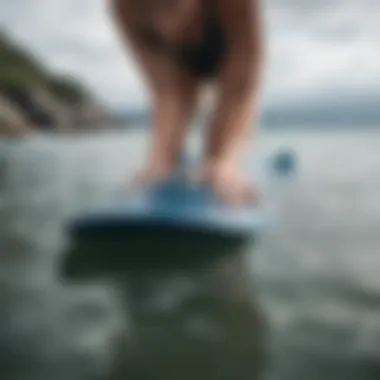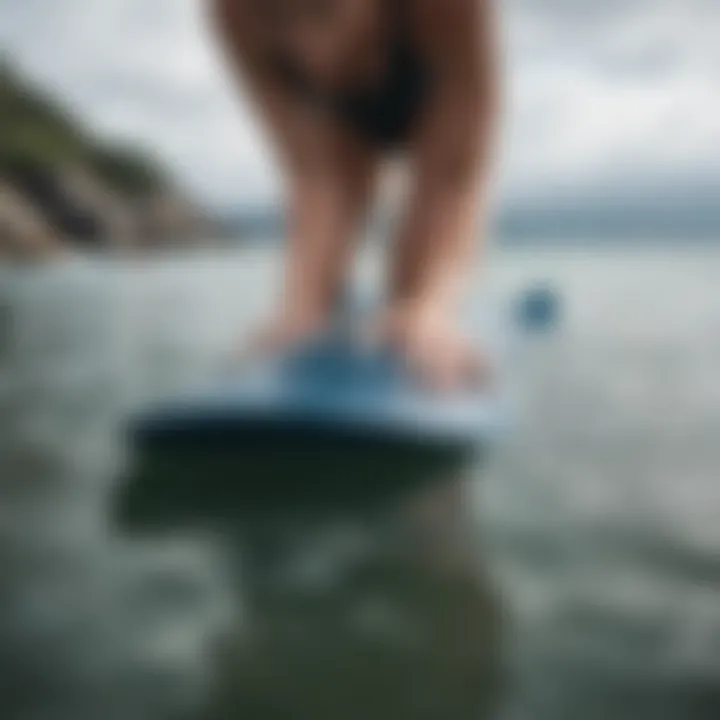Choosing the Best Fins for Ocean Swimming


Intro
Swimming in the ocean presents a unique set of challenges and delights. For all who dare to plunge into its deep blue waters, having the right fins can mark the difference between a delightful glide and a struggle against the currents. This guide delves into the integral aspect of our gear—the fins. Understanding what to look for not only enhances performance but also can offer greater safety and enjoyment.
As waves crash and tides shift, the functionality of your fins—whether you’re a weekend warrior or a seasoned competitor—plays a vital role in how you experience your aquatic adventures. It’s not just about the kicks but how well your fins suit the specific ocean conditions and your swimming style. Let’s dive into what you should consider when choosing fins, beginning with some essential recommendations.
Understanding Fin Types for Ocean Swimming
Choosing the right fins can feel like standing at the edge of a diving board, unsure whether to leap in or not. The type of fins you select for ocean swimming can significantly impact your performance and comfort as you navigate the waves. Understanding the various fin types helps you tailor your equipment to fit your swimming style and objectives.
Traditional Swim Fins
Traditional swim fins are versatile and commonly used by swimmers from novices to advanced athletes. They are designed with a wide blade that provides increased propulsion through the water. Their typical length allows swimmers to develop a strong kick, making them especially beneficial for training. One notable advantage is that they promote better technique by helping swimmers experience the resistance of water against their feet, contributing to improved overall kicking skills.
However, one must be cautious. Over-reliance on these fins can lead to improper kicking habits, especially if they become a crutch. Swimmers should balance fin use with swim practices that emphasize form and technique without them.
Short Fins
Short fins are a popular choice for those looking to enhance speed and frequency of kicking. Due to their compact size, they require less effort to use, allowing swimmers to swim longer distances with less fatigue. These fins are perfect for training, enabling swimmers to focus on improving their technique without being bogged down by longer blades.
For swimmers who lack proficiency in timing their kicks or who struggle with coordination, short fins can assist in finding the rhythm. Still, it's essential to note that they provide less propulsion than traditional fins, so swimmers must be aware of their limitations in certain ocean conditions, like strong currents.
Long Fins
Long fins are the heavyweight champions in providing propulsion, making them the go-to choice for divers, snorkelers, or those seeking to glide through the water with grace. These fins offer a larger surface area, allowing swimmers to cover more distance with each kick. This efficiency can lead to less energy expenditure in calm waters, but it may not always be ideal for intense ocean swimming scenarios where agility is key.
The trade-off here lies in maneuverability. While they help you swim faster, long fins can feel cumbersome in choppy waves or when trying to change directions quickly. Choosing long fins means committing to a style of swimming that prioritizes distance over agility, making conditions a significant factor.
Split Fins
Lastly, split fins provide a modern twist on traditional designs. With their unique shape, these fins are engineered to channel water differently, creating a powerful thrust with each kick. The split design allows for a more efficient stroke, reducing drag while still boosting speed. They tend to be lighter and more flexible, which can ease fatigue during longer swims, but they require a particular technique to maximize their benefits.
Nonetheless, while split fins have their advantages, they may not deliver the same propulsion as regular ones. Swimmers must learn to adapt their kicking technique, which can take time. In challenging ocean conditions, coupling split fins with strong swimming skills is vital to ensure safety and control.
Understanding these fin types is not just about know-how; it’s about crafting your swimming experience. Choosing a pair that aligns with your swimming goals, preferences, and the ocean conditions you face could very well enhance your adventures in the water.
Key Features to Consider
When it comes to making choices about fins for ocean swimming, several key features should hold importance in your decision-making process. Selecting fins that align with your swimming style, experience, and the ocean conditions can make a significant difference in your performance in the water. To navigate the vast options, understanding the features—including material composition, blade design, strap mechanisms, and weight—is essential. These factors influence not just comfort, but also your efficiency, stability, and overall experience while swimming.
Material Composition
Rubber
Rubber is one of the most common materials used in fins. It is durable and offers a decent amount of flexibility. Swimmers often find rubber fins provide a snug fit, which can enhance propulsion. The key characteristic of rubber is its resistance to wear and tear. However, this durability comes with weight; rubber typically tends to be heavier than other materials. Therefore, while rubber fins are sturdy, they could make your legs feel more fatigued over long swims in the ocean. The unique feature here is the mix of comfort and endurance, which might appeal to casual swimmers who prefer a more robust fin.
Silicone
Silicone fins stand out for their softness and lightness. Many swimmers appreciate how silicone can mold to the feet, providing an exceptionally comfortable experience. This material is popular for its anti-slip properties, ensuring that fins stay in place during rigorous movements in the water. However, some may argue that silicone fins lack the structural strength that rubber offers. The unique downside to consider is their potential for quicker degradation, especially with exposure to saltwater.
Plastic
Plastic fins are lauded for their lightweight nature and low cost. They are an excellent choice for beginners or those who may not be diving deep into the ocean regularly. One significant characteristic of plastic is its ability to be molded into different shapes, allowing for innovative designs. However, the trade-off often comes in fragility; they can crack or break easier than other materials. Swimmers looking for a more budget-friendly yet effective option might find plastic fins appealing.
Blade Design and Shape
Surface Area
The surface area of a fin plays a crucial role in determining how effectively it propels the swimmer through the water. Larger surface areas typically allow for greater propulsion, which can be especially beneficial when fighting against ocean currents. However, increased surface area can also lead to more resistance, making the fins feel unwieldy for some swimmers. A good balance is key when deciding on size, and individual needs should dictate whether a swimmer opts for wider or narrower blades.


Angle of Attack
The angle at which the fin blade meets the water, known as the angle of attack, can influence a swimmer's efficiency. Fins designed with an optimal angle can increase thrust without unnecessarily increasing drag. This can lead to improved performance, especially during long-distance swims. Fins with a steeper angle might provide quicker propulsion, whereas a shallower angle can lead to a smoother glide. The unique feature here is that some swimmers may benefit from experimenting with angles to find what fits their swimming technique best.
Strap and Fit Mechanisms
Adjustable Straps
Fins with adjustable straps allow for a customizable fit, which can significantly enhance comfort. This feature is particularly beneficial for swimmers who may have different foot sizes or prefer to wear booties for warmth. A well-fitted fin can prevent blisters and discomfort, enabling longer and more enjoyable swim sessions. However, these straps may require periodic adjustments to maintain the ideal snugness, which some may view as a hassle.
Closed Heel versus Open Heel
When choosing between closed heel and open heel fins, understanding your swimming style is crucial. Closed heel fins offer a more secure fit, ideal for frequent, vigorous movement. In contrast, open heel fins allow for more flexibility and are better suited for wet suits or booties. These fins can also offer a cooler sensation, making them preferable for warmer days. The main consideration boils down to personal preference and the type of swimming you envision in your outings.
Weight and Buoyancy
Lightweight Options
Lightweight fins can enhance mobility and reduce legs fatigue. For swimmers spending extended periods in the ocean, this can mean a world of difference. The ease of movement can help increase overall speed and performance. However, it's worth noting that extra lightness can sometimes come at the cost of reduced durability. Understanding your priorities—lightness versus sturdiness—will assist in making the right choice.
Neutral Buoyancy
Fins exhibiting neutral buoyancy maintain their position in the water without sinking or floating excessively. This characteristic is advantageous for advanced swimmers looking to maximize their energy and minimize any unnecessary vertical motion. Swimmers with a neutral buoyancy fin can focus on technique rather than compensating for buoyancy issues. However, finding such fins could take a little more research, as they are not as widely available in every store.
Ultimately, the right features can transform your ocean swimming experience, making it essential to examine each aspect critically.
Adjusting Fins for Comfort
Choosing fins that fit correctly can be a game changer for anyone who swims in ocean waters. Ill-fitting fins can paddle up a boatload of discomfort during swims, leading to cramps, blisters, or even worse injuries. When you're out there battling waves or encountering currents, the last thing you want is for your gear to hinder your performance. Ensuring comfort is not just about avoiding pain but about creating an experience that allows you to focus on your stroke and navigation rather than on the equipment itself.
Selecting the Correct Size
Sizing can often feel like trying to solve a Rubik's cube—tricky and sometimes frustrating. However, getting the right size for your fins is crucial. Each brand and type of fin may size a bit differently, so it’s smart to look at specific sizing guides before making a purchase. Here are some important pointers:
- Measure Your Foot: Make sure you take an accurate foot measurement. It’s easy to think you know your size, but shoe sizes often don’t translate directly to fin sizes.
- Consider the Thickness of Your Wetsuit: If you’re wearing a thicker wetsuit, it might affect how your fins fit, so factor that in when selecting your size.
- Width Matters: Some brands offer different widths. If you have wide feet, look for models designed to accommodate that.
A snug fit is paramount; you want the fins to be secure without pinching your feet. Too tight, and you might just as well be wearing vice grips. Too loose, and you’ll find you’re wasting energy trying to keep them on with every flick of your foot.
Testing Fit in Water
Even if your fins seem perfect on land, testing them in water is where the rubber meets the road. Water can change everything, trust me. It’s one thing to slip them on at the store, but when you’re in the ocean, that's when you know the real fit affects your performance. Here’s how you can effectively assess their fit:
- Submerge Yourself: Take a dip while wearing your fins. Walk around in shallow water to mimic times when you might be entering or exiting the ocean.
- Swim a Short Distance: Once you're comfortable in the shallow, swim a few laps. Pay attention to how the fins feel as you kick. Are they chafing your ankles? Does it feel like they are part of your foot, or are you constantly aware of them?
- Observe Your Fare: If they aren’t the right fit, you’ll know quickly. Any movement that feels off or creates discomfort means it’s time to rethink your selection.
"A fin's comfort is as essential as its design; both play a crucial role in optimizing your swimming performance."
Fitting fins is not merely about following a chart; it’s about real-world application. Comfort adds another layer to your overall swimming experience. Don’t overlook this step — your feet will thank you later.
Performance Considerations
Selecting the right fins for ocean swimming isn't just about style; it's about understanding how fin design translates into performance in the water. Performance considerations encapsulate several crucial factors that can significantly enhance or diminish a swimmer's effectiveness. Whether you’re blazing through waves or gliding leisurely near the shore, these elements lay the groundwork for an optimal swimming experience.
Propulsion Efficiency
Propulsion efficiency chartemplates how well your fins assist in moving you through water, which can vary significantly from one design to another. With fins, it's all about cutting through the water like a hot knife through butter, so you shouldn’t feel like you’re dragging a boat anchor behind you.
- Fin blade length and surface area play pivotal roles in propulsion. Longer, wider fins generally offer more thrust but can also require greater effort to use effectively. On the flip side, shorter fins can be easier on the legs but may not provide the same propulsion.
- Consider the angle of attack; a slight upward bend at the tip can allow for a more fluid motion, minimizing drag and maximizing forward push. This detail might seem small, but it can be the difference between a strong stroke and a sluggish one.
In essence, selecting fins that match your swimming style will ensure that you're not flailing but rather streamlining your efforts for greater speed.


Stability and Control
When battling ocean currents, stability and control are paramount. Ideally, you want fins that keep you balanced, allowing for swift but calculated movements.
- Think of fins like the tires on a car; if they’re designed well, you’ll corner smoothly and avoid skidding out. Fins with a wider base provide better stability while increasing control when navigating through rougher waters.
- Additionally, some fins come with various blade designs that can enhance stability. For instance, fins with a split design can be particularly effective in providing directional control, allowing swimmers to maintain a steady course even in choppy conditions.
- The snugness of the fit is equally important to ensure that even slight shifts won’t throw you off balance. An ill-fitting fin can feel like a misaligned tire, leading to instability and inefficiency.
Ultimately, when your fins offer the right stability, you harness your energy more effectively, thereby powering through ocean waves with confidence.
Endurance and Fatigue
Swimming with fins can amplify your speed, yet it can also increase the strain on your legs and hips. This brings us to the critical aspect of endurance and fatigue management. The right fins can help alleviate some of this pressure, enabling you to swim longer distances with ease.
- Choose fins that provide a balance between propulsion and comfort. If your fins are too rigid, fatigue can set in quicker than a week’s paycheck; thus, it’s worth experimenting with varying degrees of flex. Softer fins can be kinder on the muscles during long swims, but they might compromise speed.
- Frequent training sessions utilizing the selected fins can help condition your legs, reducing fatigue over time. This is particularly valuable for swimmers aiming for long distances or those engaged in ocean competitions.
- A good fin should also facilitate a relaxed leg position. The less your muscles have to work to keep your feet at the right angle, the longer you can swim without wearing out.
"A fin can be a swimmer's best friend or worst enemy depending on how well it complements their style and needs."
In summation, thoughtful selection based on these performance considerations can pivot your ocean swimming experience from merely adequate to remarkably efficacious. Striking this balance means you'll not only swim faster but also enjoy the water longer, making the quest for the ideal fins one worth undertaking.
Recommended Fins for Ocean Swimming
When it comes to ocean swimming, choosing the right fins is not just a matter of preference, but rather one that can significantly impact performance, comfort, and even safety. Fins are an extension of the swimmer's body, and they play a critical role in enhancing propulsion, control, and efficiency in the water. With a vast array of options available, understanding which fins can best cater to individual needs is essential for both distance and recreational swimmers alike.
Selecting fins goes hand-in-hand with knowing your swimming style, the conditions you’ll face, and your overall goals. For instance, are you aiming to swim fast against strong currents, or are you enjoying a leisurely afternoon in calmer waters? The appropriate fins can provide the necessary support to help you excel, allowing you to maximize your time spent in the ocean.
Here's how to consider the most prominent elements when selecting fins:
- Performance Needs: Different models address various demands, whether for speed, endurance, or relaxed swimming.
- Personal Fit and Comfort: Comfort cannot be overstated; ill-fitting fins can lead to blisters and discomfort. This is especially true in ocean conditions where movement might be more vigorous.
- Intended Use: Will you be scuba diving, snorkeling, or just swimming? Each requires a type of fin that caters to that specific activity.
With that overview, let’s break down the specifics around the top brands, beginner models, advanced options for serious competition, and selections that won’t break the bank.
Top Brands Overview
In the world of swim gear, a few brands consistently rise to the top in terms of quality and performance when it comes to ocean fins. Familiar names such as Cressi, Mares, and Speedo hold a reputation that speaks of reliability and durability. These brands have poured in years of research and development to create models that withstand harsh ocean conditions.
Cressi, for instance, is well-known for its excellent range of fins designed specifically for varied swimming styles, ensuring that any diver or swimmer can find something that suits them.
"A top-quality fin can make or break your experience in the water. Investing in reputable brands is a step in the right direction."
Moreover, Mares offers a unique selection of fins made with cutting-edge materials, which not only enhance responsiveness but also ensure comfort during extended use. Each brand emphasizes different aspects; thus, understanding your personal priorities can help in choosing the right one.
Models for Beginners
For those dipping their toes into ocean swimming, opting for beginner-friendly fins is crucial. These models are designed with ease of use in mind, accommodating new swimmers who may not yet be familiar with fin techniques.
Short fins, often sported by novices, grant excellent maneuverability and allow for short bursts of speed, perfect for those still mastering their technique. Models such as the Aqua Lung Vento or Cressi Light provide comfort and are adaptable to various foot sizes, ensuring a snug fit without the hassle of excessive strapping.
Key features to look for include:
- Lightweight material for ease of use
- Soft foot pocket to prevent blisters
- Short blade design helping in control
Advanced Options for Competitive Swimmers
For the serious swimmer or athlete, investing in advanced fin options can make a notable difference in training and competition. The right fin can enhance speed and efficiency, particularly useful when swimming against ocean currents or during a triathlon.
Fins like the FINIS Foam Monofin or the Speedo Biofuse are designed thoughtfully to boost propulsion with minimal effort, drawing on cutting-edge technology in footwear design. Additional aspects that competitive swimmers should consider include:
- Blade stiffness for powerful kicks
- Streamlined shape to reduce drag
These features facilitate not just swift swimming but also the development of a stronger kick and greater overall endurance.


Budget-Friendly Choices
Even if you're tight on budget, there are still solid options out there that can serve you perfectly without burning a hole in your wallet. Models like the Body Glove Flexible Fins or the Aqua Sphere Swim Fins offer reliable performance and durability at a lower price point.
Considerations for budget fins include:
- Material quality: ascertain whether they hold up to ocean elements.
- Comfort level: even economical choices should prioritize fit to avoid discomfort during swimming sessions.
- Versatility: fins that work well for both leisure and training can save you money in the long run.
In summary, selecting the right fins involves careful consideration of the specific swimming needs, budget constraints, and preferences. Armed with an understanding of brands, models, and features, swimmers of all levels can make informed choices that enhance their ocean swimming experience.
Safety Considerations While Swimming
When you're out in the churning waves, fins can be your best friends, but safety must always come first. Understanding the inherent risks of swimming in ocean waters is crucial, not just for the experience, but also for ensuring that your fins support you effectively in various conditions. This section focuses on two pivotal aspects of ocean swimming safety: being aware of ocean conditions and keeping yourself visible to others.
Awareness of Ocean Conditions
Before slipping into the water, a bit of homework is in order. Familiarizing yourself with ocean conditions is like checking the weather before a road trip. Ask yourself: what's the tide doing today? Is there a current? How’s the visibility?
- Tides and Currents: Knowing the tide schedules can mean the difference between a pleasant swim and a struggle against rough waters. Low tide might reveal certain hazards, whereas high tide can carry you out further than expected. Additionally, currents can sneak up on you. Some areas have rip currents that can yank even the strongest swimmer away from shore. Remember, if you feel yourself being pulled, it’s better to swim parallel to the beach until you escape the grip of that current.
- Weather Changes: Hurricanes and sudden storms can change ocean conditions rapidly. A serene day can turn turbulent in a heartbeat. If there are dark clouds moving in, it might be best to call it a day. Swimmers have been caught off guard by unexpectedly strong winds and waves.
- Marine Life: Being on the lookout for marine life is another part of understanding ocean conditions. Certain timeframes may attract jellyfish or other creatures that you might rather avoid. Wearing protective fins when you know you’ll encounter certain species can help safeguard your feet.
Maintaining Visibility and Tracking
Visibility in the ocean can be as elusive as the sunset behind a storm cloud. Ensuring you are seen is key not only for your safety but also for those around you. Here are some strategies to keep yourself visible:
- Use Bright Colors: Invest in fins that are bright, lively, and easily spotted in the water. Neon colors or reflective elements can make a world of difference. Let’s be real—nobody wants to be mistaken for a seal on a sunny day.
- Swim with a Buddy: There's strength in numbers. Not only does swimming with a partner provide an additional layer of safety, but it also makes spotting each other easier in an expansive ocean. Communication beforehand regarding your swimming plan can be beneficial.
- Signal Flags: Consider carrying a basic signaling device or flag if you’re swimming in an area where boats frequent. Having a means to alert others to your presence ensures you’re not just another wave in the ocean.
"A prepared swimmer is a safe swimmer; staying aware of your surroundings can save lives."
Fins Maintenance and Care
Maintaining your swim fins is just as critical as selecting the right pair. Proper care not only extends the lifespan of your fins but also ensures optimal performance during your ocean swims. The harsh saltwater environment can take a significant toll on your gear, making it essential to incorporate sound maintenance habits into your routine. Swimmers, whether new or seasoned, would benefit from understanding why taking care of fins matters. Here’s a closer look at the key elements involved in fins maintenance and care.
Cleaning and Drying Techniques
After every swim, your fins deserve a good rinse. Saltwater, sand, and other elements can degrade materials over time if left unchecked. The first step of your cleaning process should include rinsing your fins with fresh water. This helps wash away any salt buildup or sand particles clinging to the surface. A gentle scrub with your hands or a soft sponge helps remove stubborn debris. Using harsh chemicals can weaken the fin materials, so steer clear of them.
Allow your fins to air dry completely before storing them. This is a crucial step, as moisture can lead to mold and mildew growth. Lay them flat in a shaded area, avoiding direct sunlight as prolonged exposure can cause colors to fade and rubber materials to become brittle.
- Rinse with fresh water thoroughly.
- Gently scrub with a soft sponge, if necessary.
- Air dry in a shaded spot.
Employing this consistent cleaning routine will keep your fins looking fresh and maintain their integrity for your swimming adventures.
Storage Recommendations
When it comes to storing your fins, avoiding crumpling and bending is essential. Fins that are left in a cramped space can lose their shape, which may affect performance down the line. Ideally, fins should be stored flat and in a cool, dry place.
Consider using a fin bag or a designated storage box specifically designed for swim gear. This also helps prevent exposure to dust and contaminants. Hanging fins from a clip, if designed for it, can minimize creasing while keeping them easily accessible for your next outing.
Here are some storage tips to follow:
- Store fins flat to retain their shape.
- Use a protective bag to shield from dust.
- Avoid direct sunlight to prevent material damage.
Closure
In wrapping up our exploration of the optimal fins for ocean swimming, it’s clear that several factors play a vital role in shaping your experience in the water. The fins you choose can directly influence not just your propulsion but also your comfort and safety while navigating the ever-changing oceanic environment. Choosing the right fins is not simply about preferences; it’s about maximizing your performance and enjoyment.
Final Thoughts on Choosing the Right Fins
Selecting the right fins ultimately hinges on understanding your unique needs as a swimmer. Here are some key points to reflect on:
- Comfort Is Key: You’ll want fins that fit well and don't cause discomfort. Misfitting fins can lead to blisters or cramps, affecting your time in the water.
- Type Matters: Consider the type of fins that align with your swimming style. Whether you opt for short fins for quick bursts of speed or long fins for power and glide, each has its strengths.
- Material Considerations: The material of the fins affects weight, buoyancy, and flexibility. Depending on your intended purpose, select a material that will work best for you.
"The right fin can make the ocean feel like your second home. Without it, you're merely treading water."
- Training & Experience: If you’re just starting out, beginners’ options are designed to ease you in, while more seasoned athletes might benefit from advanced models that excel in performance.
- Condition Awareness: Lastly, always be mindful of ocean conditions. Your fins should complement your skills and adapt to the underwater environment to enhance safety.















